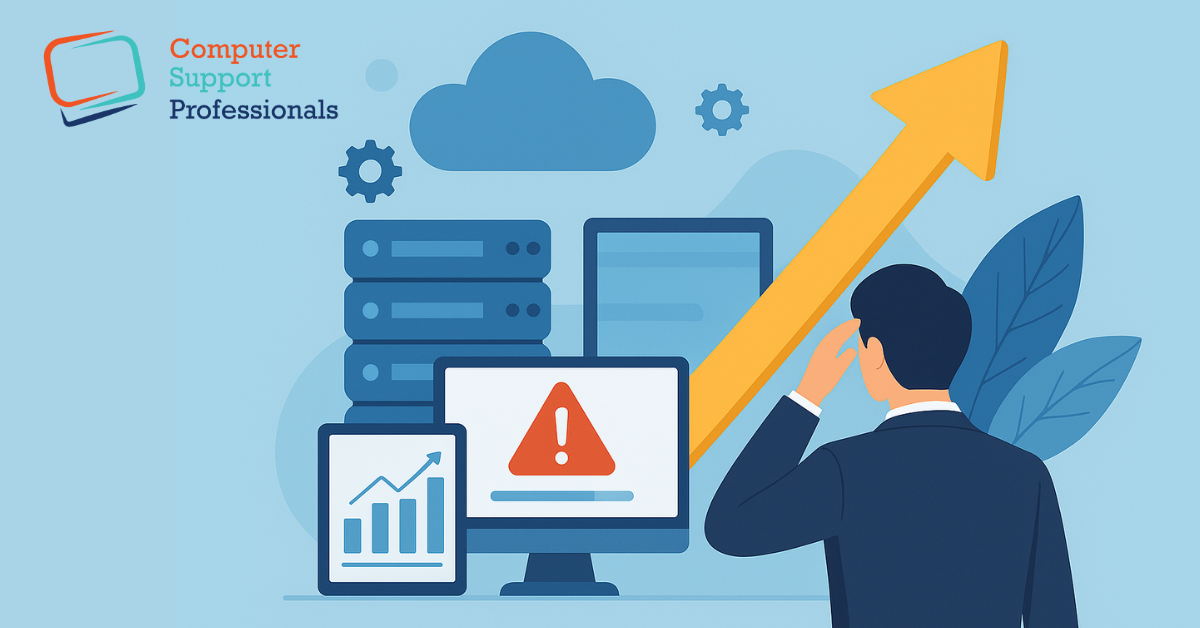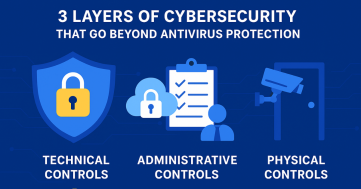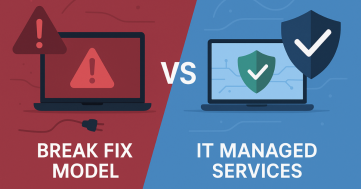Technology and IT Services are an essential component of any growing business in today’s world. It makes sure that things run smoothly, helps people talk to each other, and gives customers value. It can be a strong engine for growth when it works well. But when it is old, out of date, or weak, it becomes a silent but important barrier to growth. A lot of business leaders are confused about why their growth has stopped. They often look at market conditions or sales strategies, but they don’t realize it. The real problem is sitting right in their server rooms and on their employees’ desks.
Every business that wants to grow needs to ask itself this important question: Is our IT helping us grow or holding us back? The first step toward change is to see the signs of technological stagnation. The answer is to change the business IT approach from reactive to strategic. This can be done by making a Technology Roadmap, which is an important tool.
This article will talk about the nine most common signs that IT systems are holding you back. It will also show you how a technological roadmap can help you make sure that IT Services are in line with long-term business goals, turning a possible problem into the biggest competitive advantage.
Outdated and Misaligned IT Services
This story is very common. Business is growing quickly, and its basic IT Services, which were fine for a small team, are starting to break down under the weight of new demands. What was once a helpful tool has become a source of constant frustration, inefficiency, and risk.
Old or poorly aligned IT systems can quietly hold back business growth in big ways. They waste money by making employees less productive and needing to be fixed all the time. They also frustrate customers and make it hard for leaders to get the information they need to make smart business decisions. People often ignore the signs because they think they are just small annoyances instead of signs of a bigger problem.
It’s important to notice these signs and make a technological roadmap so that technology works with long-term business goals and helps the business grow instead of slowing it down.
9 Signs Are Limiting Business Growth
If you identify with several of the following scenarios, it’s a strong indicator that IT infrastructure requires a strategic overhaul.
Frequent Downtime and Performance Issues
The Sign: The most obvious signs are constant crashes, painfully slow networks, and software that takes a long time to load. If a customer relationship management (CRM) system takes a long time to load a record, and accounting software freezes at the end of the month, or the network goes down several times a day, the business infrastructure is telling you that it can’t handle the current needs.
The Impact: This is more than just an annoyance. Every minute of downtime hurts productivity and sales. Sales teams can’t close deals, customer service can’t help people, and employees can’t work. This results in lost income, missed deadlines, and a strong sense of reluctance among employees who must fight with their tools every day to get their work done. It shows that you can’t trust someone, which can ruin a business from the inside out.
Inability to Scale Seamlessly
The Sign: Growth should make you happy, not scared. If systems can’t handle adding new employees, opening a new location, or bringing on a big new client, you have a scalability issue. This could show up as software license limits being reached, servers reaching their maximum capacity, or important apps becoming unusably slow when more people use them at the same time.
The Impact: Making business bigger should be easy, not like trying to fit a square peg into a round hole. When technology can’t grow with you, it stops you from growing. The benefits of new growth often don’t outweigh the costs and difficulties of “making it work” with old systems, which makes people want to stay small. With a scalable IT foundation, you can go after new opportunities with confidence instead of fear.
Reliance on Manual and Repetitive Processes
The Sign: Older systems often can’t automate tasks, so people must enter, reconcile, and report data by hand. If the organization team is spending hours on tasks that could be automated, like moving data between spreadsheets, making reports by hand, or processing invoices, then technology isn’t doing its job.
The Impact: And manual work is a sign that things aren’t going well. They take a long time, are easy to mess up, and waste a lot of time for a lot of people. Also, employees are stuck doing boring, repetitive tasks instead of strategic tasks that make money. This not only wastes money, but it also makes employees unhappy and increases the number of mistakes, which can have legal and financial effects.
Integration Challenges and Data Silos
The Sign: In a healthy IT ecosystem, it’s easy for different platforms to talk to each other. If CRM doesn’t work with a marketing automation platform, e-commerce system doesn’t work with inventory management software, and the project management tool is all by itself, you probably have a problem with data silos. When information is stuck in separate systems, it can’t be accessed by other parts of the business.
The Impact: It is very hard for people from different departments to work together and make decisions when there are data silos. The sales team won’t know everything about the history of customer support, and marketing won’t be able to accurately split its audience. It’s hard to get a clear picture of how a business works because of all the different parts. Leaders must make decisions based on information that isn’t complete or that doesn’t agree with itself. This can lead to bad strategies and missed opportunities.
Outdated Hardware and Software
The Sign: Using old technology, like servers that are past their end-of-life, desktop computers that are 10 years old, or software that hasn’t been updated in years, is a ticking time bomb. Others might think everything is fine, but this is a very dangerous level of complacency.
The Impact: Using outdated technology makes you less safe. Hackers can easily break into older software and steal information from it because it doesn’t get security updates anymore. It also doesn’t have the new features that make things work better and give you new ideas. And it might not be able to use advanced data analytics, AI-powered tools, or work with others in the cloud. But you also might not be able to get to data on the go. This could make it harder for you to compete in the market. It costs more to keep these old systems running than it does to buy new ones.
Reactive IT Services Support
The Sign: IT team or managed service provider (MSP) is always putting out fires and dealing with emergencies; you are in a reactive IT cycle. The most recent crisis determines the IT strategy, and there isn’t enough time or money for proactive planning and improvement.
The Impact: If you don’t plan, operations will always be open to expensive problems. There isn’t enough time for strategic projects like making infrastructure stronger, improving security, or streamlining processes. This firefighting mode is hard on IT staff and costs the business a lot of money because it causes more frequent and severe downtime. A strategic IT function shouldn’t just react to problems; it should also work to stop them from happening in the first place.
Poor Data Management and Analytics
The Sign: If you can’t quickly and easily organize, process, or analyze data. It means that you don’t have a central place to store data, the right tools to make useful reports, or that you can’t answer simple questions about how customers behave, how well the business runs, or how well finances are doing without spending days doing manual work.
The Impact: Data is the new fuel, but only if you know how to refine it. If you don’t manage data well, you have an asset but can’t use it. Also, a company doesn’t get the information it needs to make smart choices about marketing, product development, and personalizing its customers. And business competitors who know how to use their data will always beat you by spotting trends, improving campaigns, and predicting changes in the market.
Low User Employee and Customer Satisfaction
The Sign: The most clear and urgent signs are unhappy employees and complaints from customers. If the team complains every day about how hard it is to use internal systems, and customers are unhappy with an outdated, slow, or hard-to-use customer-facing platform (like a website portal or mobile app), this means technology is not working for them.
The Impact: When employees are unhappy, they work less hard and leave the company more often. Bad customer service hurts sales, brand loyalty, and customers. In today’s world, where user experience is so important, using old technology makes customers and employees feel like you don’t care about their comfort or success. This is a serious threat to growth and reputation.
Lack of Strategic IT Services Planning
The Sign: This is the main sign that includes all the other signs. IT investments become random if there isn’t a clear, written plan for how technology will help the business reach its goals in the future. People buy technology on a case-by-case basis to solve small, immediate problems, without thinking about how it fits into the bigger picture of the business.
The Impact: Employees who are unhappy don’t work as hard as they do and quit more often. Bad customer service hurts business sales, brand loyalty, and the people who buy from you. In a world where user experience is so important, using old technology makes employees and customers think you don’t care about their comfort or success. This is a serious threat to growth and reputation.
Strategic Role of a Technology & IT Services Roadmap
If the signs above sound familiar, don’t just buy a new software package or hire another IT technician. A Technology Roadmap is the result of a strategic planning process that needs to be put in place.
A technological roadmap is a big-picture, visual strategic plan that shows how to get from where IT Services is now to where you want business to be in the future. It makes sure that technological investments are in line with business goals and sets out a clear, step-by-step plan for moving forward. It changes the topic of conversation from What broken thing do we fix today? What technology do we need to reach our three-year growth goal?
Conclusion
Technology should be the strong base on which you build your company’s future, not the secret limit that keeps you stuck in the present. If you ignore the signs of technological decay, the cost of the necessary modernization will only go up in the end, both in terms of money and operations.
Perhaps you will take charge of the IT future by being proactive and making a technological roadmap. And business turns technology from a bunch of separate problems into a useful, well-planned asset. It gives employees the power they need, makes customers happy, and gives leaders the tools and information. They need to guide the company towards growth that will last and be able to be scaled.
Don’t let old IT Services tell you what you can and can’t do. It’s time to plan.




